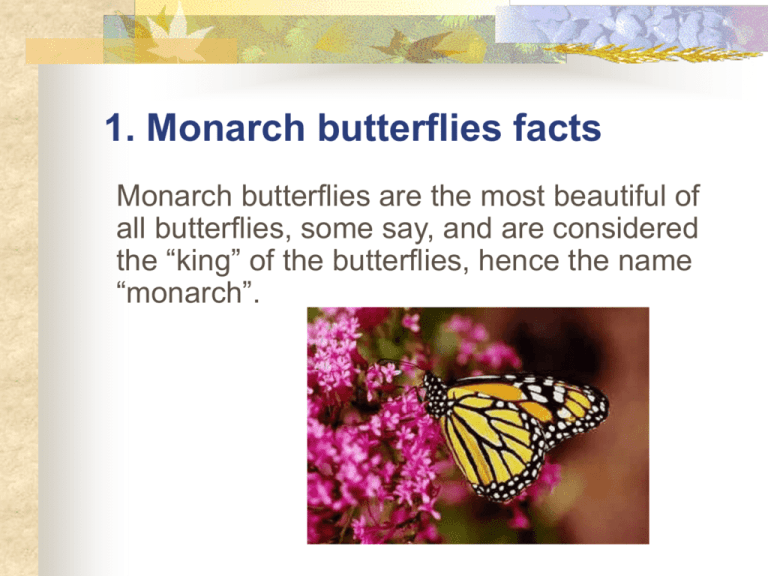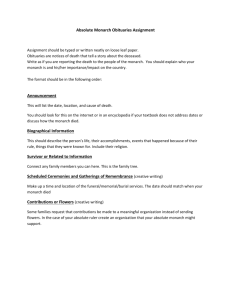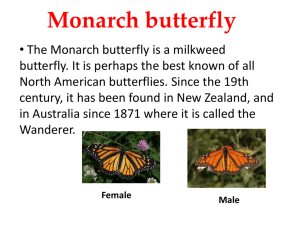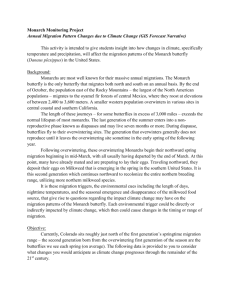monarch butterflies go through four generations each year
advertisement

1. Monarch butterflies facts Monarch butterflies are the most beautiful of all butterflies, some say, and are considered the “king” of the butterflies, hence the name “monarch”. Did you know that monarch butterflies go through four generations each year? The first three generations hatch from their cocoon state (also known as the pupa or chrysalis state) and live for up to six weeks, but the fourth generation continues to live on for up to six or eight months so that they can migrate to a warmer climate, hibernate, and then start a new first generation in the spring time. Did you know that the monarch butterflies that live in North America migrate? Monarch butterflies are the only insect to migrate up to 2,500 miles to get out of the cold weather and hibernate. But not all monarch butterflies migrate; only the fourth generation of monarchs can migrate each year because the first three generations die after about six weeks from escaping their cocoons. Did you know that monarch butterflies are poisonous? They won’t harm humans, but the chemicals from the milkweed plant that they eat when they are in the larvae stage builds up inside of them and gives them a poisonous defense against predators like frogs, birds, mice and lizards. Do you know how to tell a male from a female monarch butterfly? Female Monarchs have darker veins on their wings, and the males have a spot in the center of each hind wing from which pheromones(信息素) are released. Males are also slightly larger. Female Male 2. Monarch butterfly life cycle Monarch butterflies go through four stages during one life cycle. These four stages are the egg, the larvae (caterpillar), the pupa (chrysalis), and the adult butterfly. Adult female monarchs lay their eggs on the underside of milkweed leaves. These eggs hatch, depending on temperature, in three to twelve days. A milkweed plant The monarch butterfly is sometimes called the “milkweed butterfly” because its larvae eat the plant. In fact, milkweed (马利筋) is the only thing the larvae can eat! A monarch butterfly on milkweed Note: Once a monarch butterfly is an adult (after the metamorphosis into a full grown butterfly) it can eat the nectar from any flower, not just the milkweed plant. Only the caterpillars need the milkweed plant to live. The larvae feed on the plant leaves for about two weeks and develop into caterpillars about 2 inches long. A monarch caterpillar After awhile, the caterpillars attach themselves head down to a convenient twig, they shed their outer skin and begin the transformation into a pupa (or chrysalis), a process which is completed in a matter of hours. a Monarch pupa The pupa resembles a waxy, jade vase and becomes increasingly transparent as the process progresses. The caterpillar completes the miraculous transformation into a beautiful adult butterfly in about two weeks. The butterfly finally emerges from the now transparent chrysalis. It inflates its wings with a pool of blood it has stored in its abdomen. When this is done, the monarch expels any excess fluid and rests. The butterfly waits until its wings stiffen and dry before it flies away to start the cycle of life all over again. 3. Migration of Monarch Butterflies Monarch butterflies are not able to survive the cold winters of most of the United States so they migrate south and west each autumn to escape the cold weather. The monarch migration usually starts in about October of each year, but can start earlier if the weather turns cold sooner than that. Eastern populations winter in Florida, along the coast of Texas, and in Mexico, and return to the north in spring. Monarch butterflies follow the same migration patterns every year. During migration, huge numbers of butterflies can be seen gathered together. Those orange things in the picture are not autumn leaves... they're hundreds of Monarch butterflies! The monarch butterflies will spend their winter hibernation in Mexico and some parts of Southern California where it is warm all year long. If the monarch lives in the Eastern states, usually east of the Rocky Mountains, it will migrate to Mexico and hibernate in fir trees. If the monarch butterfly lives west of the Rocky Mountains, then it will hibernate in and around Pacific Grove, California in eucalyptus (桉树) trees. Monarch butterflies use the very same trees each and every year when they migrate, which seems odd because they aren’t the same butterflies that were there last year. These are the new fourth generation of monarch butterflies, so how do they know which trees are the right ones to hibernate in? Monarch butterflies are the only insect that migrates to a warmer climate that is 2,500 miles away each year. The Monarch butterfly migrates for 2 reasons. They can not withstand freezing weather in the northern and central continental climates in the winter. Also, the larval food plants do not grow in their winter overwintering sites, so the spring generation must fly back north to places where the plants are plentiful.






